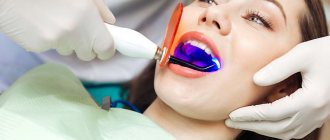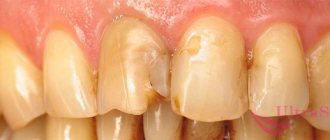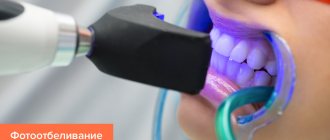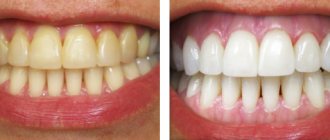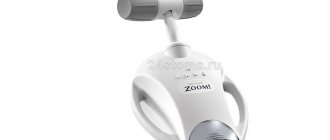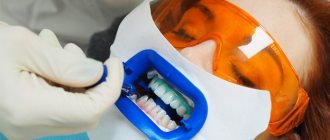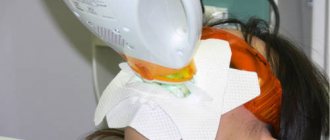Author of the article:
Soldatova Lyudmila Nikolaevna
Candidate of Medical Sciences, Professor of the Department of Clinical Dentistry of the St. Petersburg Medical and Social Institute, Chief Physician of the Alfa-Dent Dental Clinic, St. Petersburg
Cold lamp teeth whitening is one of the most modern ways to lighten enamel. The procedure is carried out using a special LED lamp with cold light.
This method is often confused with whitening with a conventional incandescent lamp, which heats the enamel, which is unsafe for the teeth, as it leads to their cracking, and also causes a lot of unpleasant sensations during the process itself. It is no wonder that patients are often distrustful of lamp bleaching.
The impact of an LED lamp is very different from a standard one; Let's figure out how effective and safe it is, and whether we should be guided by old stereotypes.
The essence of lamp whitening
It cannot be said that in this procedure, whitening occurs thanks to the light produced by the LED lamp. The bottom line is that light is only a catalyst for a chemical reaction between the reagent and the pigments that are inside the enamel and are responsible for its color.
In order to neutralize the yellow tint, a special gel based on hydrogen peroxide is applied to the teeth. Light exposure to this substance activates oxygen, which penetrates the tooth tissue and oxidizes pigments. Thus, light rays stimulate the chemical process, making the procedure safer and faster.
The main advantage of this method is that the light from the LED lamp practically does not heat the enamel, and therefore does not harm it.
Cold teeth whitening: stages
Enamel lightening with gel and a lamp is exclusively an in-office procedure that should be performed by a trusted specialist. Otherwise, you risk damage to the enamel, irritation of the oral mucosa and other problems.
The whitening itself lasts about an hour and is carried out in several stages.
Preparation
Before any whitening, no matter which method you choose, you should prepare your teeth very carefully:
- Firstly, this concerns the elimination of various scratches and chips on the enamel, as well as the treatment of caries. If you don't do this, the active gel may get into the cracks and act too deeply on the tissue, which will cause you a lot of discomfort both during and after the procedure.
- Secondly, pay special attention to fillings and implants; their color will not change due to bleaching, so it is better to choose temporary options and install permanent ones after the procedure. Otherwise, the color of your smile will not be uniformly white.
- Thirdly, mechanical or ultrasonic cleaning is always necessary before whitening; it will remove soft and hard plaque from the teeth, which will help determine the natural color of your enamel as accurately as possible. Cleaning itself will make your smile one or two shades brighter. Next, you can choose the color of the enamel using a special VITA scale. Next, the bleaching itself begins.
Stages
- The first stage begins with preparing the oral cavity for the procedure; this is necessary to protect the soft tissues. The cheeks and lips are isolated using various napkins and films so that the gel does not accidentally come into contact with them when treating teeth. A protective composition is also applied to the gums so that the aggressive effects of the gel do not cause irritation and other problems. The most popular option is liquid rubber dam; the advantage of this composition is that it quickly hardens, forming a dense protective film.
- The second stage is the whitening procedure itself, the surface of the teeth is thoroughly dried and then evenly coated with the active composition. Next, the teeth are irradiated with an LED lamp for about 10 minutes and the gel is removed. If the color is not white enough, the procedure is carried out again. During one visit to the dentist, it is possible to make no more than three approaches.
- Special restorative compounds are applied to the teeth.
The whole procedure takes about an hour. The result is individual for everyone, so do not despair if you did not get the desired color on your first visit; most likely, with repeated procedures you will achieve the desired shade.
Whitening and Professional Cleaning: Similarities and Differences
Professional cleaning is a mechanical removal of plaque; it does not change the shade of the teeth and is a preparatory step before whitening. Whitening consists of a chemical effect on the pigmentation of teeth, their surface changes its shade to a lighter one.
Types of whitening:
- professional - effective and fast way;
- homemade (using trays and whitening gel) - at home this is a long process that can take several months, it is not always possible to achieve a noticeable effect;
- intracoronal - performed on an individual tooth when its shade changes, the indication for which is trauma or endodontic treatment.
Professional whitening takes a little over an hour. The doctor uses special equipment (lamp, laser). It is designed to activate the gel. Philips Zoom lamp whitening! WhiteSpeed (Zoom 4) can change the color of enamel by several tones in one visit to the doctor.
How effective is teeth whitening with LED light?
Modern cold bleaching is a very effective method. Depending on your individual characteristics, in one visit to the dentist you can lighten your tooth enamel by about 6-10 shades. Provided that your teeth have acquired a yellow tint due to food or smoking. If your enamel has acquired a gray tint, lightening with an LED lamp will not give significant results, that is, the shade will change by 2-3 tones. In addition, the procedure will not work if a change in the healthy color of the enamel is caused by taking tetracycline antibiotics or an excess of fluoride in the body.
The results of whitening with an LED lamp can last for several years, depending on the natural shade of the enamel and how carefully you follow your dentist's recommendations.
Why does tooth enamel darken?
To get the most out of lamp whitening, you need to understand the causes of darkening of tooth enamel. In most cases, it is enough to eliminate the negative impact and clean the teeth so that the color of the teeth becomes natural again.
Dentin has a dark shade, which shines through a thin layer of enamel. A fair question arises: how does it happen that dentin darkens if the enamel is strong and can protect the tooth from many negative factors?
The reason is quite simple. It lies in the universal love for solid foods and sour drinks. Seeds, nuts, lemonades and other similar products contribute to the deformation of the upper layer of teeth. Through scratches and chips, pigments easily penetrate into the tooth tissue, staining the dentin.
The main factors influencing the color of teeth:
- The most popular reason is the consumption of foods that contain large amounts of coloring substances. These can be the following things: cranberries, blueberries, beets, strawberries, various candies and sodas, coffee, strong tea and much more. If this is the reason for the darkening of your teeth, then careful hygiene and periodic professional cleaning (once or twice a year) will help.
- Change • Change in enamel color is common in smokers. The main problem here is the tar that is in the cigarette. Together with smoke, they fall on the surface of the teeth and settle in the form of a dark plaque. Gradually, this sediment destroys tooth enamel, which can lead to caries and more serious diseases. In addition, smoking also has a negative impact on your gums. The best option in this case would be to quit smoking completely. If this is not possible for you, try to reduce your cigarette consumption to a minimum and pay more attention to oral hygiene.
- The tooth may darken due to injury, which led to damage to the neurovascular bundle. In this case, consultation with a specialist is necessary. Until the cause is eliminated, whitening will not help lighten the tooth.
- The shade may change due to the removal of the nerve; the darkening may not appear immediately, but also requires the intervention of a specialist.
- Filling a canal can lead to staining of the enamel; it all depends on the material used to fill the hole.
- Progressive caries is an advanced case of ordinary caries. The fact is that if such damage is not eliminated, small black spots will increase, destroying the enamel and then the dentin.
- Teeth may have congenital characteristics that are in no way related to caries or other damage. They can differ in structure, tone, shape, and so on. In some cases, it is possible to change their color only with the help of special overlays - veneers.
- Excess fluoride in the water you drink can lead to fluorosis. At the beginning of the disease, dark spots or chalky streaks appear on the teeth. The progression of the disease leads to the destruction of enamel and then dentin. Whitening such teeth is not possible until you get rid of fluorosis.
- Taking tetracycline antibiotics during pregnancy can negatively affect the condition of the baby's teeth.
How is it different from other methods?
There are many whitening methods: laser, home, Air Floor, Zoom, etc.
It can be very difficult to choose just one from such a variety of means. The patient is not always familiar with all the features and disadvantages of in-office lightening procedures. What makes the choice especially difficult is the emergence of more and more new methods, for example, light teeth whitening. It came to us from the USA quite recently, but has already earned recognition. How is it different from other professional techniques?
- The peroxide concentration in the Beyond system's brightening gel is 35-37% - this is more than that of the home system (10-15%), so the effect of cold light is much more noticeable and requires only 3 sessions of 10 minutes. Changing the color of enamel at home takes place in courses and takes more than a week.
- After using the Zoom technique, the patient may experience increased tooth sensitivity or unwanted tanning of the face due to harmful UV rays. The light from cold bleaching acts through filters; they neutralize dangerous radiation.
- Compared to the laser method, light technology is several times cheaper.
- Devices with ultraviolet lamps can often cause burns or damage the mucous membrane. To protect the patient, the dentist carefully covers the entire oral cavity with a special cloth. This makes the whitening process much more difficult. Halogen blue light lamp does not heat soft and hard periodontal tissues.
Benefits of lamp teeth whitening
The main advantage of the LED lamp, which is used for teeth whitening, is the almost complete absence of harm to the patient. This method has passed all clinical trials and is considered one of the safest. Radiation from the source passes through a special filter that neutralizes the negative effects of ultraviolet and infrared radiation. The temperature of the enamel surface during the procedure does not exceed 37.6ºC.
You can also note other advantages of cold whitening:
- Short procedure time;
- The ability to get the desired result in one go;
- The active gel applied to the teeth has a special composition that helps reduce sensitivity to the procedure.
- The system allows you to whiten teeth that have darkened with age or their color is a consequence of fluorosis.
The disadvantage of the procedure is its high cost and a long list of contraindications.
Contraindications
You should not resort to whitening with an LED lamp in the following cases:
- high sensitivity of teeth;
- defects on enamel;
- pregnancy or lactation (there are other methods);
- intolerance to the active components that make up the gel;
- fixed dentures, crowns or a large number of fillings;
- The procedure is also not recommended for children under 16 years of age;
- caries, periodontitis and other diseases.
In the latter case, the ban is temporary, since the procedure can be carried out after you have treated your teeth.
Sequence of the procedure
Before performing the procedure, the patient wears protective equipment: glasses, an insert for the mouth and face. The procedure consists of several stages:
- professional cleaning;
- determination of the initial color of teeth;
- protection of soft tissues using insulating material;
- covering the gingival margin with a protective gel;
- distribution of whitening gel over the upper and lower teeth in the smile line;
- activation of the gel using equipment (from 3 to 4 cycles, each cycle takes up to 10-15 minutes depending on the characteristics of the whitening lamp);
- each cycle is carried out using a new portion of whitening gel;
- rinsing off the gel;
- remineralization of teeth.
When whitening using Philips Zoom technology! WhiteSpeed (Zoom 4) exposure occurs using ultraviolet radiation. Warm and cold light lamps are used. The procedure is repeated several times until maximum results are achieved.
Philips Zoom lamp! WhiteSpeed (Zoom 4) is positioned so that the light falls simultaneously on the upper and lower teeth in the smile line. Under its influence, active oxygen is released from the components of the whitening gel. Its molecules eliminate the most persistent stains from the tooth surface. Upon completion of whitening, a drug is applied to further strengthen the tooth enamel.
The gel itself also contains special components that protect the surface of the teeth and reduce the sensitivity of the enamel to external factors. This happens not only during the procedure, but also in the future: the enamel becomes stronger and less sensitive.
How to save the result
Once you've gotten the whiteness you wanted, don't forget that your teeth now need more careful care. For a week, it is best to follow a clear (white) diet, the essence of which is to exclude coloring or very hot foods. It is also better to reduce your cigarette consumption.
In addition, professional products from the ASEPTA series for oral care will help you. They will prevent the appearance of yellow plaque, caries and other troubles, for example, ASEPTA Sensitive toothpaste will help reduce tooth sensitivity after the procedure. In the future, you can use ASEPTA PLUS Remineralization or Gentle Whitening toothpaste to maintain a snow-white and healthy smile.
Sources:
- Report on determining/confirming the preventive properties of toothpaste “ASEPTA PLUS” GENTLE WHITENING” Author: doctor-researcher A.A. Leontyev, head Department of Preventive Dentistry, Doctor of Medical Sciences, Professor S.B. Ulitovsky First St. Petersburg State Medical University named after. acad. I.P. Pavlova, Department of Preventive Dentistry
- Report on the determination/confirmation of the preventive properties of personal oral hygiene products “ASEPTA PLUS” Remineralization doctor-researcher A.A. Leontyev, head Department of Preventive Dentistry, Doctor of Medical Sciences, Professor S.B. Ulitovsky First St. Petersburg State Medical University named after. acad. I.P. Pavlova, Department of Preventive Dentistry
- Clinical studies of antisensitive toothpaste “Asepta Sensitive” (A.A. Leontyev, O.V. Kalinina, S.B. Ulitovsky) A.A. LEONTIEV, dentist O.V. KALININA, dentist S.B. ULITOVSKY, Doctor of Medical Sciences, Prof. Department of Therapeutic Dentistry, St. Petersburg State Medical University named after. acad. I.P. Pavlova
- Report on determining/confirming the preventive properties of toothpaste “ASEPTA PLUS” COFFEE and TOBACCO Author: doctor-researcher A.A. Leontyev, head Department of Preventive Dentistry, Doctor of Medical Sciences, Professor S.B. Ulitovsky. First St. Petersburg State Medical University named after. acad. I.P. Pavlova, Department of Preventive Dentistry
Saving and consolidating the result
The duration of preservation of the effect and whiteness of teeth depends on several reasons:
- compliance with personal hygiene rules (daily brushing, preventive visits to the dentist);
- absence of bad habits (smoking has a detrimental effect on the color of enamel);
- dietary habits (frequent consumption of foods with dyes).
As practice shows, for different people the results last for up to 2-3 years. To prolong the effect and long-lasting whiteness of your teeth, you should constantly take care of your teeth, use a suitable toothpaste (low-abrasive for teeth after professional whitening), visit a doctor in a timely manner, carry out treatment and eliminate dental problems. It is recommended to have your mouth professionally cleaned every 6 months.
